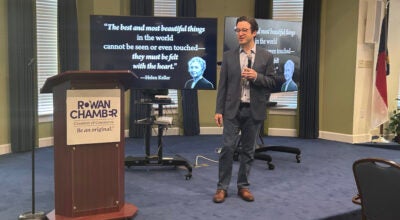tough to recruit females Colleges eye women as engineers
Published 12:00 am Friday, January 12, 2007
ATLANTA (AP) — Georgia Tech freshman Val Uyemura caught a glimpse of her future even before she started classes in electrical engineering.
“When I went to orientation, they split us up by major and I was the only woman,” said Uyemura, 18, from the Atlanta suburb of Smyrna.
The startling reality of the gender imbalance in engineering wasn’t enough to scare her away. Still, Uyemura — whose parents have engineering degrees — admits being just one of 87 women enrolled in an 855-student major can be intimidating.
“Women need a more personal relationship,” she said, referring to the way females learn.
The perception that engineering lacks a personal touch is one of the main reasons, experts say, that more women aren’t engineers. Nationally, women make up only about one-fifth of students in engineering programs, virtually the same share as a decade ago.
“One of the reasons has to do with the negative stereotype in engineering — the nerd drinking Cokes and eating Twinkies until 3 in the morning,” said William Wulf, president of the National Academy of Engineering. “The really important attribute of an engineer is creativity. Somehow that’s not what high school girls are hearing about.”
A 2003 study by the University of Michigan’s Institute for Research on Women and Gender found that females choose other careers because they don’t see engineering as a way to help others. The study, conducted over 17 years, followed Michigan students from 6th grade through college and beyond.
Women — which make up more than half of the nation’s population — are vital to helping the U.S. remain competitive in science and engineering, Wulf said. The U.S. lags behind countries like China and India in producing engineers and scientists out of college each year, and women and minorities are key to improving that standing, he said.
Besides, they bring the diverse perspectives needed for the innovation that can set the U.S. apart, Wulf said.
No one can figure out why programs designed to encourage female engineers aren’t working. Georgia Tech offers annual engineering camps for middle- and high-school girls, and the university’s students and alumni regularly visit schools to talk to science and math classes. A mentoring program also connects female engineering majors in their third and fourth years with freshmen who want to major in engineering.
Still, female enrollment hasn’t changed much at the Atlanta university in the last decade.
Mahera Philobos, director of Georgia Tech’s Women in Engineering program and a civil and environmental engineering professor, said she’s had success getting women to enroll in some areas of engineering, like biomedical and industrial. Both are perceived by women as fields that make contributions to the world, she said.
While frustrated by the stagnant enrollment, Philobos knows change happens slowly. She said the key is reaching the girls when they’re in middle and high school to encourage them to take rigorous math and science courses.
Compare Georgia Tech to the Massachusetts Institute of Technology in Cambridge, Mass., where the same types of programs have yielded 36 percent female enrollment in undergraduate engineering. And Smith College in Northampton, Mass., an all-female institution, launched an engineering program in 1999 to help produce more women engineers to work in the industry and teach engineering.
That does not translate into a national trend. Women received 18 percent of the 78,200 engineering degrees given out in 2003-04, the latest data available from the U.S. Department of Education. That’s the same percentage as in 1998 and only slightly more than the 16 percent in 1996.
“There are some very focused efforts reaching a small set of the number of young women graduating each year,” said Betty Shanahan, executive director and CEO of the Society of Women Engineers. “One of the challenges we face is reaching more.”
The society just received a $1 million grant from the ExxonMobil Foundation for more outreach, including building a Web site with podcasts and interactive information. The society also is training Girl Scout leaders, high school counselors and parents to encourage girls to go into engineering.




